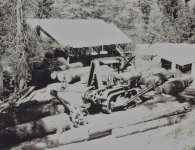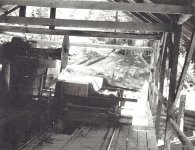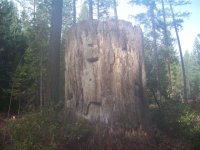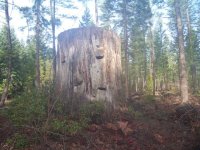From:
A War, The Chainsaw And The 2nd Great Cutting Of The Northwest | KLCC
Tree cutting became far quicker and easier because the war helped push the most iconic symbol of modern logging the chainsaw into the hands of the Northwest logger.
It changed the industry forever.
...
The pre-WWII chainsaw wasn't exactly a grab-and-go piece of machinery. It took two men to use one. One man would grab the engine, and the other would take a hold of a handle attached to the chain end.
The early versions were designed to saw vertically for bucking cutting the fallen tree to the proper length for the mill. Tipping the saws would disrupt the fuel flow and kill the engine.
Loggers were wary about taking them on, University of Oregon historian Steven Beda says. One reason was fear the chainsaws would reduce the number of men needed to work in the woods. There were more practical unpleasantries as well.
The early chainsaws were loud, they were nasty, they spit oil, they spit gas, Beda says.
But World War II's demand for raw materials changed the dynamic.
The rhythmic thump of the ax and the sweet song of the hand saw gradually faded as Northwest forests filled with the harsh buzz of the two-man chainsaw.
That helped Northwest loggers cut so much lumber for the war effort that had it not been required for barracks, crates, and the like it could have framed 3.5 million modern houses.
Cheaper, Lighter, More Powerful
But the two-man saw wasn't long for the woods.
Manufacturing had improved rapidly during the war. Within a few years of V-J Day, the one-man chainsaws started to show up.
The fact that a chainsaw now becomes a lot cheaper and a lot more easy to manufacture has to do with this new industrial infrastructure created as a consequence of the war, Beda says.
Paul Skirvin remembers when the one-man chainsaw appeared at retailers in the Northwest.
We got our first power saw then, from Monkey Ward, I think it was, he remembers, referring to the department store Montgomery Ward.
The 60-pound one-man chainsaw meant Skirvin and his brother could work much faster.
After you got a power saw, man, just zip it a lot faster. Ten, five, eight times faster, Skirvin says.
A War, The Chainsaw And The 2nd Great Cutting Of The Northwest | KLCC
Tree cutting became far quicker and easier because the war helped push the most iconic symbol of modern logging the chainsaw into the hands of the Northwest logger.
It changed the industry forever.
...
The pre-WWII chainsaw wasn't exactly a grab-and-go piece of machinery. It took two men to use one. One man would grab the engine, and the other would take a hold of a handle attached to the chain end.
The early versions were designed to saw vertically for bucking cutting the fallen tree to the proper length for the mill. Tipping the saws would disrupt the fuel flow and kill the engine.
Loggers were wary about taking them on, University of Oregon historian Steven Beda says. One reason was fear the chainsaws would reduce the number of men needed to work in the woods. There were more practical unpleasantries as well.
The early chainsaws were loud, they were nasty, they spit oil, they spit gas, Beda says.
But World War II's demand for raw materials changed the dynamic.
The rhythmic thump of the ax and the sweet song of the hand saw gradually faded as Northwest forests filled with the harsh buzz of the two-man chainsaw.
That helped Northwest loggers cut so much lumber for the war effort that had it not been required for barracks, crates, and the like it could have framed 3.5 million modern houses.
Cheaper, Lighter, More Powerful
But the two-man saw wasn't long for the woods.
Manufacturing had improved rapidly during the war. Within a few years of V-J Day, the one-man chainsaws started to show up.
The fact that a chainsaw now becomes a lot cheaper and a lot more easy to manufacture has to do with this new industrial infrastructure created as a consequence of the war, Beda says.
Paul Skirvin remembers when the one-man chainsaw appeared at retailers in the Northwest.
We got our first power saw then, from Monkey Ward, I think it was, he remembers, referring to the department store Montgomery Ward.
The 60-pound one-man chainsaw meant Skirvin and his brother could work much faster.
After you got a power saw, man, just zip it a lot faster. Ten, five, eight times faster, Skirvin says.



